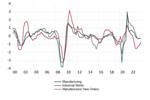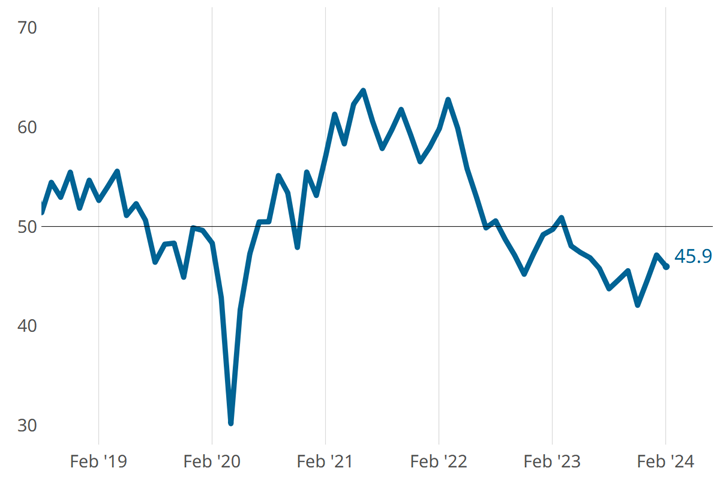Moldmaking Activity Returns to Accelerated Contraction
February’s index dropped from the more positive readings seen in January, landing on par with July 2023 and remaining in contraction mode.
GBI: Moldmaking activity was down 1.2 points from January. Source (All Images) | Gardner Intelligence
Moldmaking activity accelerated contraction in February despite most components moving in positive directions (i.e., slowed contraction). The Gardner Business Index (GBI) Moldmaking ended February at a reading of 45.9, down 1.2 points from January.
February’s slowed contraction in new orders, production and backlog suggests accelerated contraction in the total index may be short-lived. (This graph shows three-month moving averages.)
New orders (by more than 3 points), production and, for the first time in a long time (call it a year) backlog, were led by slowed contraction in February. Employment saw little change and the exports component — after accelerating contraction last month — wobbled back to slowing contraction to about the same degree.
Supplier deliveries remained flat while expectations of future business (not part of the GBI calculation) continued to leap despite the total index continuing to contract or register “flat” at best. There are reasons to hope — it is only a matter of time before the magnitude of slowing component contraction catches up in terms of real business expansion, which is in line with the positive sentiment indicated by business expectations.
Related Content
-
Moldmaking GBI Returns to Contraction After One-Month Respite
After a challenging move into the 50s in March, the April GBI returned to a mostly consistent state of contraction, the result of recent market dynamics.
-
May Moldmaking Index Trends Downward
Contraction, experienced by most May components, continues to be familiar territory for the GBI: Moldmaking Index.
-
GBI: Moldmaking Undertakes Slightly Slowing Contraction
While most component activities remained unchanged in September, employment and supplier deliveries indicate a brief let-up from the contraction trend.














